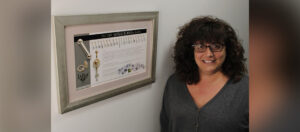The industry is scrambling to fill roles as professionals retire and the interest in entering the profession remains low
By Deborah Jeanne Sergeant
The Bureau of Labor Statistic’s occupational outlook handbook predicts between 2021 and 2031 approximately 136,400 openings for the category of accountants and auditors annually.
“The continued globalization of business may lead to increased demand for accounting expertise and services related to international trade and international mergers and acquisitions,” the BLS states on its website.
Technology may lighten the load and boost efficiency, but “this change is not expected to reduce overall demand,” the BLS states.
This translates to a big problem for accounting firms.
“This is an industry-wide issue,” said Todd J. Klaben, CPA and partner at The Bonadio Group in Syracuse, which operates nine offices in New York, Texas and Vermont. “It’s been affecting not only Central New York but across our entire profession.”
Retiring baby boomers, early retirees and a lack of interest in entering the profession are among the reasons the industry is scrambling to fill roles. Klaben pointed out that the work–life balance may not seem reasonable to young people looking for a career, with its long hours and busy tax seasons.
There’s also the five-year program required before taking the CPA exam.
“A lot of students look at that and the cost benefit,” Klaben said. “If I have to go to school another year, I’m losing out on another year of being in a career and paying more to get it. Is it worth it?”
The pandemic spurred employers to offer remote work and continue to offer it once restrictions were lifted. Klaben said that has led to an exodus from Central New York firms for ones in larger cities. The accountants still live in the area; they’re just working for big-city firms that can pay a salary out of reach for local firms.
“We can use more accountants. It’s not just affecting the practice area, but also higher education,” said Heather J. Holcomb, assistant professor of accounting and women in business adviser at SUNY Oswego. “If you look statewide and nationwide, the enrollment in accounting programs has dropped.”
With fewer students enrolling in accounting programs, fewer accountants are available to replace the retiring baby boomers in accounting. For those who do want to pursue accounting, fewer spots are available. Holcomb said that for years, fewer instructors have been available for teaching accounting classes, creating a pipeline issue.
Holcomb said that an industry organization, the American Institute of Certified Public Accountants, looked at the issue with the National Association of State Boards of Accountancy, a forum for the nation’s 55 state boards of accountancy, which administer the CPA examination. Their work resulted in a new CPA exam, effective in January 2024.
“It revamps the exam in terms of content, which will focus more on analytics and technology and changes it from four core parts to three core parts and three different discipline tracks which they’ll choose: business analysis and reporting; tax emphasis such as personal financial and tax planning; and IT,” Holcomb said.
Industry leaders hope that this will help the CPA license relevant with what businesses need and draw a more diverse group of CPA candidates.
Holcomb also sees the need to “rebrand” the profession as one that more young people will find attractive — not stodgy number cruncher banging on a 10-key and memorizing ever-changing tax code, but a career that could include entrepreneurship, nonprofits, banking or government roles.
She also wants more CPA firms to creatively recruit, such as tapping students while still in middle school and school to consider the CPA career path and reaching out to community college students to encourage students to continue their education.
Dannible & McKee, LLP operates offices in Syracuse, Auburn, Binghamton and Schenectady and employs 70 CPAs. Chris Didio CPA, managing partner and CFE, also said that the severe shortage has been challenging. The firm recruits at SUNY Oswego, Syracuse University, Lemoyne and other schools.
Didio thinks that students appear more interested in majors related to IT, investment and general business. However, “what they’re missing is that there’s such a good opportunity to obtain a regional job at CPA firm,” he said. “So many have hiring needs. These students are almost guaranteed a job to learn about the industry. It opens the doors to so many fields. They don’t have to spend their entire career in CPA work. Some of our CPAs have gone to work for the FBI, private business and elsewhere.”
The firm has responded to the problem by expanding its intern program to 20 students last year, which is about three times as many as in previous years. Once students have completed two years of their CPA program, they can come onboard as an intern. Last year, 10 of the firm’s interns completed their degrees and had job offers before graduation.
Didio hopes that increasing the firm’s work–life balance will help draw more candidates, as many people like working remotely at least some of the time. But the long-term solution appears to lie in evangelizing students about CPA work.
“We have to get our interns we’ve hired back on campus to educate the business students as to what a successful career they could have,” Didio said.




